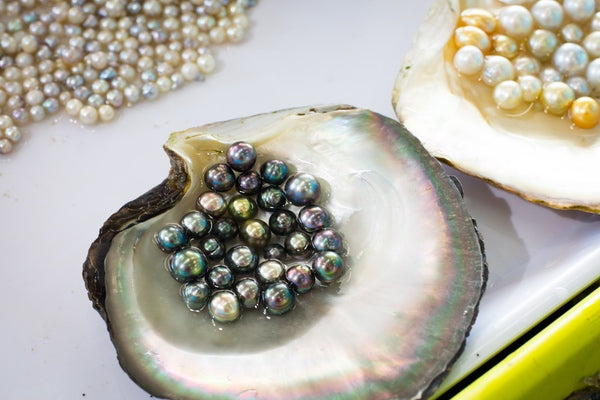Where do natural pearls grow?
While natural pearls were found around the world in the past, their desirability and value lead to over harvesting, to the point that shellfish stocks were depleted. Today, finding a natural pearl is extremely rare.
How to tell the difference between natural and cultured pearls?
Telling the difference between natural pearls and cultured pearls requires evaluation under a microscope by a pearl specialist. however, given the rarity of natural pearls, it is safe to assume that any pearl you are looking at is a cultured pearl.
Natural pearls are rare, very rare.
Today, cultured pearls provide a consistent supply making them readily available.
But natural pearls — and those of any significant size and uniformity — have always been extraordinarily rare.
This was so much so, that the supply couldn’t meet the demands of kings and queens who prized them above all else.
Queen Elizabeth I had such an obsession with pearls, that craftsmen created the original imitation pearls to adorn her famous pearl-covered dress.
Here are a few famous pearls that stand out among these rare gems.
The Arco Valley Pearl

Found in the Arco Valley of Bavaria, this huge nacreous blister pearl dates back to at least the 12th century.
Reportedly, Kublai Khan, the emperor of China, gave this 575-carat natural blister pearl to Marco Polo who took it home to Europe.
It measures 78mm x 41mm x 35 mm and has overtones of pink and brown.
Following Polo’s death, it was sold and resold to various ruling monarchies.
Eventually, it made its way back to an aristocratic family in Austria, not far from its origins in Bavaria.
Considered the second largest saltwater pearl, this pearl came from a clam and is not considered gem quality.
The Abernathy Pearl

From the 12th century onward, pearls from freshwater mussels in Scotland’s rivers were sold in European markets.
By the 16th century, seeking freshwater pearls had established itself as an industry complete with “river bailiffs” who supervised the mussels to be sure they weren’t exploited and made sure all the most valuable pearls went to the kings and queens.
The industry thrived until the 19th century Industrial Revolution polluted the waterways damaging the mussel population.
But in 1967, a professional pearl diver, Bill Abernathy, found a 14.26-carat natural freshwater pearl in the River Tay.
It is considered the most perfect pearl ever found in Scotland’s rivers. Its size makes it rarer.
To this day it is on display at Cairncross of Perth, a jewelry store in Perth Scotland.
The Hope Pearl

The largest and most famous natural saltwater pearl, the Hope Pearl weighs 450 carats, or approximately 4 ounces!
It is a white, drop-shaped blister pearl, measuring approximately 2 x 4 inches.
In color, it ranges from greenish-gold on one end to white on the other.
Discovered in the early 19th century, Henry Philip Hope — who also owned the Hope Diamond — purchased the pearl for his collection which totaled 150 natural pearls.
In the early 1900s his descendants sold the pearl in order to pay debts.
At one point, Christie’s auction house had it and loaned the magnificent pearl to the Smithsonian.
La Peregrina (The Pilgrim)
Discovered off the coast of Panama in the 16th century, La Peregrina was promptly delivered to King Phillip II of Spain who presented the gem to his new bride, Queen Mary of Spain.
Originally it weighed 223.8 grains or 55.95 carats. Much later, it was drilled for setting, and the final weight is 203.8 grains.
It was the most celebrated pearl of its time, prized for its size, perfect pear shape, and bright white coloration.
Subsequently, La Peregrina belonged to Queen Margaret and Joseph Bonaparte before the British Marquis of Abercorn acquired it.
It’s most famous owner? Despite the kings and queens who owned it, actress Elizabeth Taylor is its most famous owner.
Actor Richard Burton purchased La Peregrina as a Valentine’s Day gift for her in 1969. He paid only $37,000 for it — a pittance by today’s standards.
Following her death, the gorgeous pearl, diamond, and ruby necklace set a record at auction, selling for more than $11 million.

Elizabeth Taylor wearing La Peregrina stands next to a portrait of Queen Mary of England wearing it.
Mary was married to King Philip II of Spain, and she was the older sister of Elizabeth I of England.
Their father was Henry VIII. Following Mary’s death in 1558, La Peregrina returned to the Crown of Spain where it remained for 250 years.
